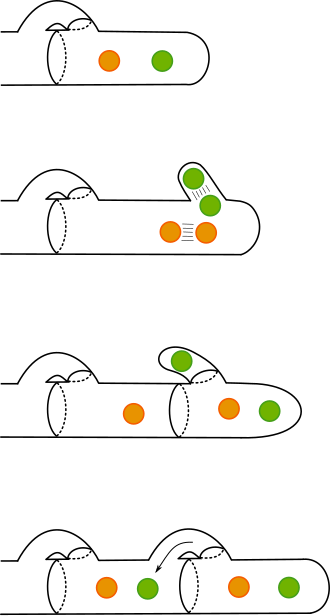Clamp connection
Clamp connections are a distinctive feature found in the hyphae of certain fungi, particularly within the Basidiomycota phylum. These specialized structures play a crucial role in the fungal life cycle, especially in the process of sexual reproduction and nuclear division. Understanding clamp connections is essential for mycologists and those studying fungal biology, as they are key indicators of the organism's taxonomy and reproductive mechanisms.
Overview
A clamp connection forms when a hypha undergoes cell division to create a new cell. Instead of simply dividing, the parent cell develops a small loop or bridge that connects the mother cell to the daughter cell. This structure ensures the proper distribution of nuclei during cell division. In basidiomycete fungi, the presence of clamp connections is often associated with the dikaryotic stage of the life cycle, where two genetically distinct nuclei coexist in a single hyphal cell.
Function
The primary function of clamp connections is to maintain the dikaryotic state of the hyphae. During the dikaryotic phase, each cell division must be accompanied by the migration of one nucleus from each parent into the new cell. Clamp connections facilitate this process by forming a bridge through which one nucleus can move to the new cell, ensuring that both cells maintain a dikaryotic state. This mechanism is crucial for the eventual production of basidiospores, the reproductive spores of Basidiomycota fungi.
Formation
The formation of a clamp connection begins with the initiation of a new cell division. A small outgrowth appears on the side of a hypha, which elongates and curves back toward the parent cell. As the cell division proceeds, one nucleus migrates into the outgrowth, while the other remains in the parent cell. A septum then forms to divide the new cell from the parent, with the clamp connection ensuring the transfer of the nucleus into the new cell. This complex process is regulated by various genetic and environmental factors.
Significance in Fungal Biology
Clamp connections are not only vital for the reproductive success of Basidiomycota fungi but also serve as an important morphological feature for the identification and classification of species within this group. The presence or absence of clamp connections, along with their structure, can help mycologists differentiate between closely related species and understand their evolutionary relationships.
Research and Applications
Research on clamp connections has contributed to our understanding of fungal genetics, cell biology, and evolution. By studying these structures, scientists can gain insights into the mechanisms of nuclear division and genetic recombination in fungi. Additionally, understanding how clamp connections influence fungal growth and reproduction can have practical applications in fields such as agriculture, where fungi play both beneficial and harmful roles.
Transform your life with W8MD's budget GLP-1 injections from $125.
W8MD offers a medical weight loss program to lose weight in Philadelphia. Our physician-supervised medical weight loss provides:
- Most insurances accepted or discounted self-pay rates. We will obtain insurance prior authorizations if needed.
- Generic GLP1 weight loss injections from $125 for the starting dose.
- Also offer prescription weight loss medications including Phentermine, Qsymia, Diethylpropion, Contrave etc.
NYC weight loss doctor appointments
Start your NYC weight loss journey today at our NYC medical weight loss and Philadelphia medical weight loss clinics.
- Call 718-946-5500 to lose weight in NYC or for medical weight loss in Philadelphia 215-676-2334.
- Tags:NYC medical weight loss, Philadelphia lose weight Zepbound NYC, Budget GLP1 weight loss injections, Wegovy Philadelphia, Wegovy NYC, Philadelphia medical weight loss, Brookly weight loss and Wegovy NYC
|
WikiMD's Wellness Encyclopedia |
| Let Food Be Thy Medicine Medicine Thy Food - Hippocrates |
Medical Disclaimer: WikiMD is not a substitute for professional medical advice. The information on WikiMD is provided as an information resource only, may be incorrect, outdated or misleading, and is not to be used or relied on for any diagnostic or treatment purposes. Please consult your health care provider before making any healthcare decisions or for guidance about a specific medical condition. WikiMD expressly disclaims responsibility, and shall have no liability, for any damages, loss, injury, or liability whatsoever suffered as a result of your reliance on the information contained in this site. By visiting this site you agree to the foregoing terms and conditions, which may from time to time be changed or supplemented by WikiMD. If you do not agree to the foregoing terms and conditions, you should not enter or use this site. See full disclaimer.
Credits:Most images are courtesy of Wikimedia commons, and templates, categories Wikipedia, licensed under CC BY SA or similar.
Translate this page: - East Asian
中文,
日本,
한국어,
South Asian
हिन्दी,
தமிழ்,
తెలుగు,
Urdu,
ಕನ್ನಡ,
Southeast Asian
Indonesian,
Vietnamese,
Thai,
မြန်မာဘာသာ,
বাংলা
European
español,
Deutsch,
français,
Greek,
português do Brasil,
polski,
română,
русский,
Nederlands,
norsk,
svenska,
suomi,
Italian
Middle Eastern & African
عربى,
Turkish,
Persian,
Hebrew,
Afrikaans,
isiZulu,
Kiswahili,
Other
Bulgarian,
Hungarian,
Czech,
Swedish,
മലയാളം,
मराठी,
ਪੰਜਾਬੀ,
ગુજરાતી,
Portuguese,
Ukrainian
Contributors: Prab R. Tumpati, MD



